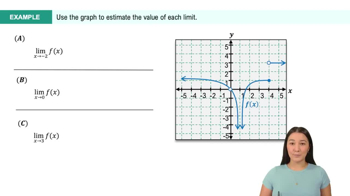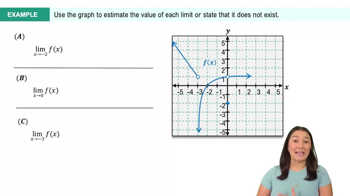Table of contents
- 0. Functions7h 52m
- Introduction to Functions16m
- Piecewise Functions10m
- Properties of Functions9m
- Common Functions1h 8m
- Transformations5m
- Combining Functions27m
- Exponent rules32m
- Exponential Functions28m
- Logarithmic Functions24m
- Properties of Logarithms34m
- Exponential & Logarithmic Equations35m
- Introduction to Trigonometric Functions38m
- Graphs of Trigonometric Functions44m
- Trigonometric Identities47m
- Inverse Trigonometric Functions48m
- 1. Limits and Continuity2h 2m
- 2. Intro to Derivatives1h 33m
- 3. Techniques of Differentiation3h 18m
- 4. Applications of Derivatives2h 38m
- 5. Graphical Applications of Derivatives6h 2m
- 6. Derivatives of Inverse, Exponential, & Logarithmic Functions2h 37m
- 7. Antiderivatives & Indefinite Integrals1h 26m
1. Limits and Continuity
Introduction to Limits
Problem 2.7.17
Textbook Question
Suppose |f(x) − 5|<0.1 whenever 0<x<5. Find all values of δ>0 such that |f(x) − 5|<0.1 whenever 0<|x−2|<δ.
 Verified step by step guidance
Verified step by step guidance1
Step 1: Understand the problem statement. We are given that |f(x) - 5| < 0.1 for 0 < x < 5. We need to find a δ > 0 such that |f(x) - 5| < 0.1 whenever 0 < |x - 2| < δ.
Step 2: Recognize that this is a problem about continuity and limits. Specifically, it is related to the definition of a limit at a point, where we want to ensure that f(x) is close to 5 when x is close to 2.
Step 3: Consider the interval 0 < x < 5. Since we want 0 < |x - 2| < δ, we are focusing on values of x that are close to 2 but still within the interval (0, 5).
Step 4: Choose δ such that the interval (2 - δ, 2 + δ) is contained within (0, 5). This ensures that for any x in (2 - δ, 2 + δ), the condition 0 < x < 5 is satisfied, and thus |f(x) - 5| < 0.1 holds.
Step 5: Determine the largest possible δ by considering the boundaries of the interval (0, 5) and the point x = 2. The largest δ will be the minimum of the distances from 2 to the endpoints of the interval (0, 5).
Recommended similar problem, with video answer:
 Verified Solution
Verified SolutionThis video solution was recommended by our tutors as helpful for the problem above
Video duration:
2mPlay a video:
Was this helpful?

 6:47m
6:47mWatch next
Master Finding Limits Numerically and Graphically with a bite sized video explanation from Callie
Start learning





